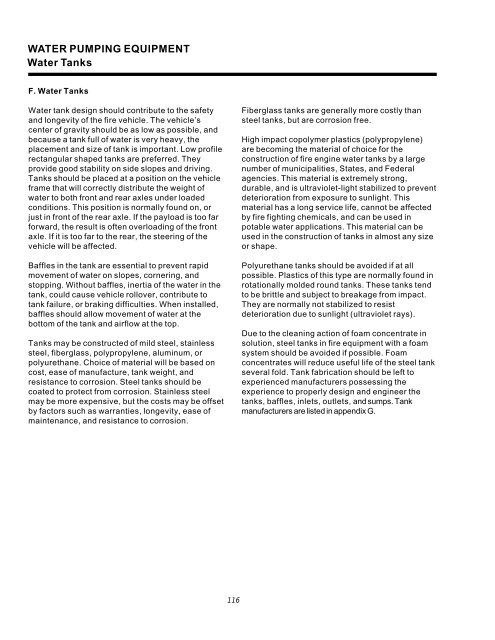Water Handling Equipment Guide - National Wildfire Coordinating ...
Water Handling Equipment Guide - National Wildfire Coordinating ...
Water Handling Equipment Guide - National Wildfire Coordinating ...
You also want an ePaper? Increase the reach of your titles
YUMPU automatically turns print PDFs into web optimized ePapers that Google loves.
WATER PUMPING EQUIPMENT<br />
<strong>Water</strong> Tanks<br />
F. <strong>Water</strong> Tanks<br />
<strong>Water</strong> tank design should contribute to the safety<br />
and longevity of the fire vehicle. The vehicle’s<br />
center of gravity should be as low as possible, and<br />
because a tank full of water is very heavy, the<br />
placement and size of tank is important. Low profile<br />
rectangular shaped tanks are preferred. They<br />
provide good stability on side slopes and driving.<br />
Tanks should be placed at a position on the vehicle<br />
frame that will correctly distribute the weight of<br />
water to both front and rear axles under loaded<br />
conditions. This position is normally found on, or<br />
just in front of the rear axle. If the payload is too far<br />
forward, the result is often overloading of the front<br />
axle. If it is too far to the rear, the steering of the<br />
vehicle will be affected.<br />
Baffles in the tank are essential to prevent rapid<br />
movement of water on slopes, cornering, and<br />
stopping. Without baffles, inertia of the water in the<br />
tank, could cause vehicle rollover, contribute to<br />
tank failure, or braking difficulties. When installed,<br />
baffles should allow movement of water at the<br />
bottom of the tank and airflow at the top.<br />
Tanks may be constructed of mild steel, stainless<br />
steel, fiberglass, polypropylene, aluminum, or<br />
polyurethane. Choice of material will be based on<br />
cost, ease of manufacture, tank weight, and<br />
resistance to corrosion. Steel tanks should be<br />
coated to protect from corrosion. Stainless steel<br />
may be more expensive, but the costs may be offset<br />
by factors such as warranties, longevity, ease of<br />
maintenance, and resistance to corrosion.<br />
Fiberglass tanks are generally more costly than<br />
steel tanks, but are corrosion free.<br />
High impact copolymer plastics (polypropylene)<br />
are becoming the material of choice for the<br />
construction of fire engine water tanks by a large<br />
number of municipalities, States, and Federal<br />
agencies. This material is extremely strong,<br />
durable, and is ultraviolet-light stabilized to prevent<br />
deterioration from exposure to sunlight. This<br />
material has a long service life, cannot be affected<br />
by fire fighting chemicals, and can be used in<br />
potable water applications. This material can be<br />
used in the construction of tanks in almost any size<br />
or shape.<br />
Polyurethane tanks should be avoided if at all<br />
possible. Plastics of this type are normally found in<br />
rotationally molded round tanks. These tanks tend<br />
to be brittle and subject to breakage from impact.<br />
They are normally not stabilized to resist<br />
deterioration due to sunlight (ultraviolet rays).<br />
Due to the cleaning action of foam concentrate in<br />
solution, steel tanks in fire equipment with a foam<br />
system should be avoided if possible. Foam<br />
concentrates will reduce useful life of the steel tank<br />
several fold. Tank fabrication should be left to<br />
experienced manufacturers possessing the<br />
experience to properly design and engineer the<br />
tanks, baffles, inlets, outlets, and sumps. Tank<br />
manufacturers are listed in appendix G.<br />
116
















